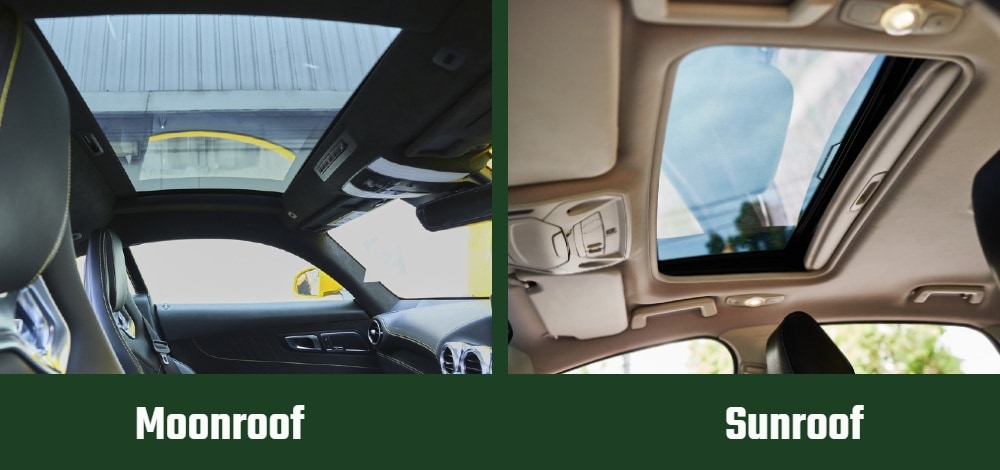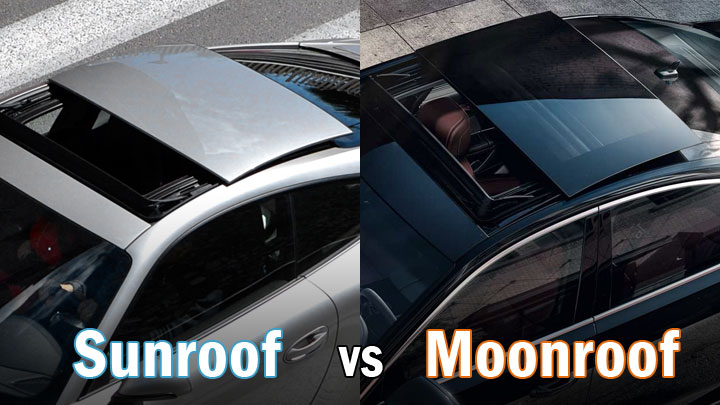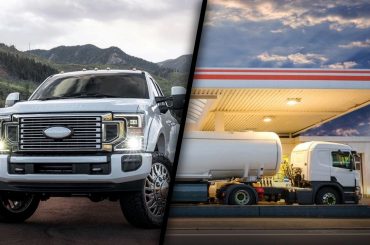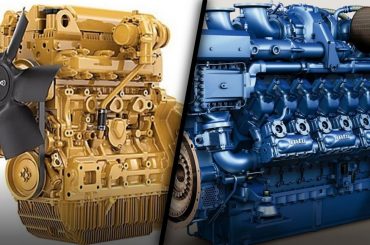Both moonroofs and sunroofs provide your vehicle with plenty of light and fresh air. There are no similarities beyond that.
Open-air carriages were the first horseless carriages and were more of a curiosity. The cost of building closed-body cars decreased after World War I. In cities and towns across the country, closed-body motor vehicles became the dominant mode of transportation by the early 1920s.
In the late 1920s, sliding “sunshine” roofs were introduced to satisfy drivers’ desire for the open road. In the 1950s and 1960s, convertibles were popular, and sunroofs were out of style.
Most convertible models disappeared during the 1970s due to effective factory air conditioning, strict government rollover regulations, and economic factors. The demand for sunroofs and moonroofs increased as a result. There are distinct differences between the terms, but they are often used interchangeably today.
What’s the Difference Between a Sunroof and a Moonroof?
-
The sunroof can be popped open or removed. Originally, they were solid panels painted the same color as the body. Glass or acrylic sheets are used in modern versions and aftermarket installations.
-
Moonroofs were historically fixed transparent panels. The modern moonroof consists of tinted glass panels that slide on tracks, powered by motors.
-
A retractable sunshade or panel is built into most moonroofs to help reduce interior temperatures.
-
Even when closed, moonroofs let light into the passenger compartment.
-
A moonroof is larger than a sunroof.
-
A solid panel sunroof is less likely to be broken by thieves than a glass moonroof.
-
Typically, a factory-installed moonroof costs about $1,500, while a pop-up sunroof costs about $650.
-
Repairing or replacing damaged moonroof drive cables or motors can cost up to $1,000, depending on the vehicle and trim.

Pros and Cons of a Moonroof
Pros
-
You can feel happier and more carefree when you have an open moonroof.
-
Even when closed, it provides an infinite view of the sky.
-
Being in a convertible with less chance of getting sunburned or messing up your hair.
-
A fabric convertible top does not provide the same level of safety and security.
-
A visually pleasing addition to any vehicle.
-
Your vehicle’s resale value may increase.
Cons
-
It is expensive to install and repair.
-
Headroom is reduced by mechanical assembly.
-
Fuel economy and handling can be affected by additional weight.
-
Bad seals or clogged drain tubes can cause leaks.
Pros and Cons of a Sunroof
Pros
-
When open, it offers a better view of your surroundings.
-
With all windows lowered, there is an increase in airflow, reducing the need for air conditioning during summer.
-
Reception on cell phones is better.
-
It offers better security than a glass moonroof or a fabric convertible top.
-
Installed or repaired at a lower cost than a moonroof.
-
Headroom is not affected.
-
You may be able to resell your vehicle for more money if you do this.
Cons
-
Turbulence in the air makes it noisy.
-
When closed, solid panels block the view of the sky.
-
When removed, must be stored in trunk.
-
Bad seals can lead to leakage.
Sunroof Installation
You can add a moonroof or sunroof to your car or truck using DIY kits and specialty shops, depending on the make, model, and year of your vehicle.
It’s best to leave this to the professionals.
Any vehicle’s roof is an integral structural component. In particular, cutting cross-support beams welded to the underside of a roof panel weakens the entire body assembly. There will likely be extensive body repairs and additional wiring required to install a power sliding moonroof. If you’re even the slightest bit unsure, defer to the pros.
You can, however, install a pop-up sunroof yourself if you’re willing to try:
-
Make sure the kit fits your vehicle exactly by measuring the roof.
-
Protect your eyes with eye protection. It is not optional to do this.
-
If there are wires, lamps, or electronics hidden behind the headliner, remove any trim securing it, along with the headliner itself.
-
Tape the roof with painter’s tape.
-
Tape the ends of the sunroof to hold it in place after placing the kit’s cutout template on the roof.
-
Trace around the template with an exact knife, cutting into the tape as you go. Paint shouldn’t be cut.
-
A quarter-inch hole should be drilled at each corner, about an inch inside the line you scribed on the tape. Once you drill the holes, there is no going back!
-
Use a jigsaw or nibbler tool (preferred) to carefully cut along the line.
-
Remove the cut panel carefully while wearing work gloves. Sheet metal edges will be sharp.
-
Any leftover metal should be removed. If there are burrs, sharp edges, or jagged edges, smooth them out with a file.
-
Any exposed metal should be sanded, cleaned, and rustproofed with primer. To prevent the exposed metal from rusting, spray on a coat of clear coat once it is dry. Dry the primer and clear coat completely.
-
The weather seal may or may not be attached to the roof assembly depending on the kit. If the seal needs to be installed separately, follow the manufacturer’s instructions.
-
The sunroof panel must be removed from the frame.
-
Drop in the outer roof assembly/frame into the prepared hole once the seal is in place.
-
Slide the lower support inner frame into the outer frame from inside the car. Use the hardware provided to attach.
-
The adhesive strips that came with your kit should be installed now if they were included. Protect the side facing you by not removing the protective covering.
-
The headliner must be reinstalled with the wires, electronics, and anything else that has been removed.
-
After the sunroof is installed, reinstall the headliner and trim it carefully.
-
Remove the protective covering protecting the adhesive strips once the headliner is correctly fitted.
-
Make sure the adhesive strips are securely attached to the headliner.
-
Trim, wires, lamps, electronics, etc., should be reinstalled.
-
Install the finishing trim if it came with the kit.
-
Check for leaks after placing the sunroof panel into the assembly.
The Final Word
A sunroof or moonroof is a nice accessory for a car. Keep the tracks clean and vacuumed regularly to keep them working properly. Any moving parts should be lubricated with dry lube. At least once a year, clean the drain channels and seals to prevent problems.
Using a soft one-eighth-inch plastic tube or pipe cleaner, clean the drain tube openings (located at the four corners of the sunroof or moonroof). Pour a cup of water into the drain channel at a time once the drain tubes are clear of debris. When water drips from underneath your vehicle, you know the drain is open.




